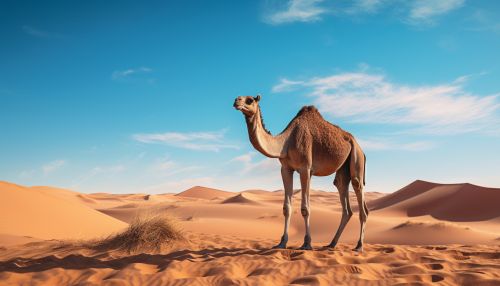Camelidae
Taxonomy and Evolution
Camelidae is a family of large, even-toed ungulates within the order of Artiodactyls. The family is divided into three subfamilies: Camelinae, Lamini, and Merycoidodontinae. The Camelinae subfamily includes two genera, Camelus and Camelops, while the Lamini subfamily includes four genera, Lama, Vicugna, Hemiauchenia, and Palaeolama. The extinct subfamily Merycoidodontinae is known from fossil records.
The evolution of the Camelidae family is a subject of ongoing research. The family is believed to have originated in North America during the Eocene epoch, approximately 45 million years ago. The earliest known camelid is Protylopus, a small, forest-dwelling creature. Over time, camelids adapted to a variety of environments, from the cold climates of the Pleistocene epoch to the arid regions of modern-day Africa and Asia.


Anatomy and Physiology
Camelidae are known for their distinctive physical characteristics, including long legs, a long neck, and either one or two humps. The humps are made of fat, which can be metabolized for energy during periods of food scarcity. The long legs and neck allow camelids to browse on vegetation that is out of reach for other herbivores.
Camelidae have a number of physiological adaptations to arid environments. They can tolerate dehydration and high body temperatures, and their kidneys are highly efficient at conserving water. Camelids also have unique blood cells that are oval in shape, rather than the typical round shape seen in other mammals. This allows their blood to continue flowing smoothly even when the animal is dehydrated.
Behavior and Ecology
Camelidae are typically social animals, living in groups called herds. The social structure of a herd varies depending on the species. Some species, like the dromedary camel, have a strict hierarchy, with a dominant male leading the herd. Other species, like the guanaco, have a more egalitarian social structure.
Camelidae are herbivores, with a diet that consists mainly of grasses and shrubs. Some species, like the Bactrian camel, are known to eat a wider variety of plants, including thorny, salty, or bitter plants that other animals avoid.
Human Interaction
Humans have interacted with camelids for thousands of years. Some species, like the dromedary and Bactrian camels, have been domesticated and are used for transportation, milk, meat, and wool. Other species, like the alpaca and llama, are primarily kept for their wool, which is used in textiles.
In recent years, there has been increasing interest in the conservation of wild camelids. Some species, like the vicuña, are threatened by habitat loss and illegal hunting. Conservation efforts are focused on protecting these species and their habitats, as well as educating the public about the importance of camelids to ecosystems and human societies.
